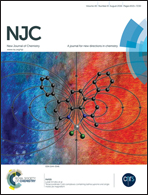Enantioselective recognition of ascorbic acid and isoascorbic acid on HS-β-cyclodextrin/gold nanoparticles/hollow carbon microspheres hybrid modified electrodes
Abstract
The HS-β-cyclodextrin/gold nanoparticles/hollow carbon microspheres (HS-β-CD/AuNPs/HCMS) hybrids were successfully synthesized and characterized via scanning electron microscopy (SEM), energy-dispersive X-ray spectroscopy (EDX), Fourier transform infrared spectroscopy (FT-IR), cyclic voltammetry (CV) and electrochemical impedance spectroscopy (EIS). A simple and reliable chiral sensing platform constructed from the prepared hybrids was used for enantioselective recognition of ascorbic acid (AA) and isoascorbic acid (IAA). Moreover, the stereoselectivity of HS-β-CD/AuNPs/HCMS to AA or IAA was investigated via differential pulse voltammetry (DPV). The results showed obvious differences in the peak currents of AA and IAA, demonstrating that this strategy could be employed to enantioselectively recognize AA and IAA. Under the optimum conditions, the chiral sensor exhibited an acceptable linear response to AA or IAA in the linear range of 1.0 × 10−4 to 5.0 × 10−3 M with a limit of detection of 1.7 × 10−5 M (S/N = 3). This approach provided a new available sensing interface to recognize and determine AA or IAA by electrochemical technology.


 Please wait while we load your content...
Please wait while we load your content...